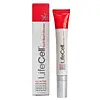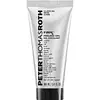What's inside
What's inside
 Key Ingredients
Key Ingredients

 Benefits
Benefits

 Concerns
Concerns

 Ingredients Side-by-side
Ingredients Side-by-side

Water
Skin ConditioningC12-15 Alkyl Benzoate
AntimicrobialAvena Sativa Kernel Extract
AbrasiveButyrospermum Parkii Butter
Skin ConditioningCetearyl Alcohol
EmollientSilicon
AbrasiveTitanium Dioxide
Cosmetic ColorantGlycerin
HumectantCetearyl Glucoside
EmulsifyingSclerotium Gum
Emulsion StabilisingIron Oxides
Thioctic Acid
AntioxidantTetrahydrobisdemethoxydiferuloylmethane
AntioxidantSpilanthes Acmella Flower Extract
Skin ConditioningRetinol
Skin ConditioningMalus Domestica Fruit Cell Culture Extract
Skin ConditioningMagnesium Ascorbyl Phosphate
AntioxidantGlycine Soja Oil
EmollientZinc Carbonate Hydroxide
BufferingCaprylic/Capric Triglyceride
MaskingHydroxyethyl Acrylate/Sodium Acryloyldimethyl Taurate Copolymer
Emulsion StabilisingPhenoxyethanol
PreservativeTribehenin
EmollientSodium Acrylate/Sodium Acryloyldimethyl Taurate Copolymer
Emulsion StabilisingCeramide Ns
Skin ConditioningEthylhexylglycerin
Skin ConditioningPalmitoyl Oligopeptide
CleansingPalmitoyl Tetrapeptide-7
Skin ConditioningRetinyl Palmitate
Skin ConditioningPEG-10 Rapeseed Sterol
CleansingHesperidin Methyl Chalcone
AntioxidantSteareth-20
CleansingPalmitoyl Tripeptide-5
Skin ConditioningAcetyl Hexapeptide-8
HumectantDipeptide-2
Skin ConditioningCholecalciferol
Ubiquinone
AntioxidantTocopherol
AntioxidantTocopheryl Acetate
AntioxidantSodium Hyaluronate
HumectantZea Mays Oil
EmulsifyingAscorbyl Palmitate
AntioxidantWater, C12-15 Alkyl Benzoate, Avena Sativa Kernel Extract, Butyrospermum Parkii Butter, Cetearyl Alcohol, Silicon, Titanium Dioxide, Glycerin, Cetearyl Glucoside, Sclerotium Gum, Iron Oxides, Thioctic Acid, Tetrahydrobisdemethoxydiferuloylmethane, Spilanthes Acmella Flower Extract, Retinol, Malus Domestica Fruit Cell Culture Extract, Magnesium Ascorbyl Phosphate, Glycine Soja Oil, Zinc Carbonate Hydroxide, Caprylic/Capric Triglyceride, Hydroxyethyl Acrylate/Sodium Acryloyldimethyl Taurate Copolymer, Phenoxyethanol, Tribehenin, Sodium Acrylate/Sodium Acryloyldimethyl Taurate Copolymer, Ceramide Ns, Ethylhexylglycerin, Palmitoyl Oligopeptide, Palmitoyl Tetrapeptide-7, Retinyl Palmitate, PEG-10 Rapeseed Sterol, Hesperidin Methyl Chalcone, Steareth-20, Palmitoyl Tripeptide-5, Acetyl Hexapeptide-8, Dipeptide-2, Cholecalciferol, Ubiquinone, Tocopherol, Tocopheryl Acetate, Sodium Hyaluronate, Zea Mays Oil, Ascorbyl Palmitate
Water
Skin ConditioningPEG-32
HumectantCellulose
AbsorbentButylene Glycol
HumectantCitrus Aurantium Bergamia Fruit Water
Skin ConditioningSorbitol
HumectantR-Bacillus Licheniformis Keratinase
Skin ConditioningAnanas Sativus Fruit Extract
Skin ConditioningLactobacillus/Punica Granatum Fruit Ferment Extract
Skin ConditioningLeuconostoc/Radish Root Ferment Filtrate
AntimicrobialSodium Hyaluronate
HumectantGlycerin
HumectantSodium Hydroxide
BufferingCitric Acid
BufferingTetrasodium EDTA
Algin
MaskingCarbomer
Emulsion StabilisingTromethamine
BufferingIsopropyl Myristate
EmollientSodium Chloride
MaskingCalcium Chloride
AstringentPotassium Sorbate
PreservativeSodium Benzoate
MaskingMica
Cosmetic ColorantPhenoxyethanol
PreservativeWater, PEG-32, Cellulose, Butylene Glycol, Citrus Aurantium Bergamia Fruit Water, Sorbitol, R-Bacillus Licheniformis Keratinase, Ananas Sativus Fruit Extract, Lactobacillus/Punica Granatum Fruit Ferment Extract, Leuconostoc/Radish Root Ferment Filtrate, Sodium Hyaluronate, Glycerin, Sodium Hydroxide, Citric Acid, Tetrasodium EDTA, Algin, Carbomer, Tromethamine, Isopropyl Myristate, Sodium Chloride, Calcium Chloride, Potassium Sorbate, Sodium Benzoate, Mica, Phenoxyethanol
Alternatives
Ingredients Explained
These ingredients are found in both products.
Ingredients higher up in an ingredient list are typically present in a larger amount.
Glycerin is already naturally found in your skin. It helps moisturize and protect your skin.
A study from 2016 found glycerin to be more effective as a humectant than AHAs and hyaluronic acid.
As a humectant, it helps the skin stay hydrated by pulling moisture to your skin. The low molecular weight of glycerin allows it to pull moisture into the deeper layers of your skin.
Hydrated skin improves your skin barrier; Your skin barrier helps protect against irritants and bacteria.
Glycerin has also been found to have antimicrobial and antiviral properties. Due to these properties, glycerin is often used in wound and burn treatments.
In cosmetics, glycerin is usually derived from plants such as soybean or palm. However, it can also be sourced from animals, such as tallow or animal fat.
This ingredient is organic, colorless, odorless, and non-toxic.
Glycerin is the name for this ingredient in American English. British English uses Glycerol/Glycerine.
Learn more about GlycerinPhenoxyethanol is a preservative that has germicide, antimicrobial, and aromatic properties. Studies show that phenoxyethanol can prevent microbial growth. By itself, it has a scent that is similar to that of a rose.
It's often used in formulations along with Caprylyl Glycol to preserve the shelf life of products.
Sodium Hyaluronate is hyaluronic acid's salt form. It is commonly derived from the sodium salt of hyaluronic acid.
Like hyaluronic acid, it is great at holding water and acts as a humectant. This makes it a great skin hydrating ingredient.
Sodium Hyaluronate is naturally occurring in our bodies and is mostly found in eye fluid and joints.
These are some other common types of Hyaluronic Acid:
Learn more about Sodium HyaluronateWater. It's the most common cosmetic ingredient of all. You'll usually see it at the top of ingredient lists, meaning that it makes up the largest part of the product.
So why is it so popular? Water most often acts as a solvent - this means that it helps dissolve other ingredients into the formulation.
You'll also recognize water as that liquid we all need to stay alive. If you see this, drink a glass of water. Stay hydrated!
Learn more about Water